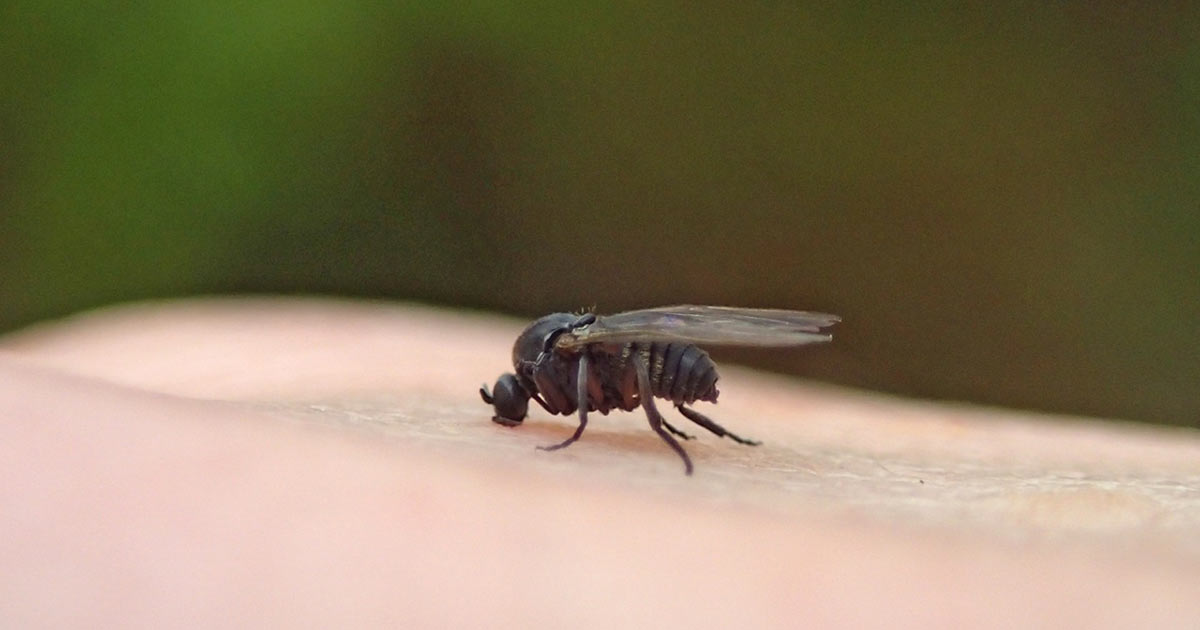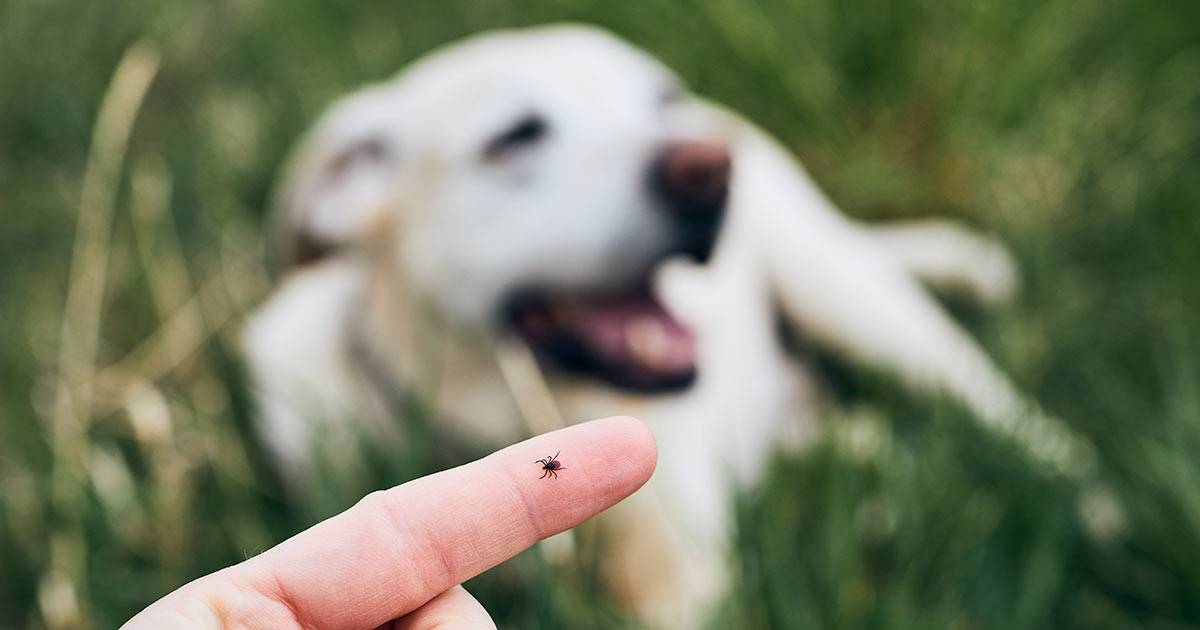How to Kill and Prevent Fleas in Your Yard
Fleas can infest even the best-groomed, most-loved dogs and cats. If your pet's relentless scratching has you looking for answers, start with your own backyard. Flea infestations aren't just embarrassing; these pests can transmit disease-causing pathogens that strike wildlife, pets and humans.1 Fleas that pets pick up outdoors often end up indoors, too. By learning to identify flea problems and taking action, you can get rid of fleas and protect your family against their return.
- Recognizing Fleas and Flea Problems
- Understanding Flea Life Cycles
- Protecting Against Fleas and Flea Bites
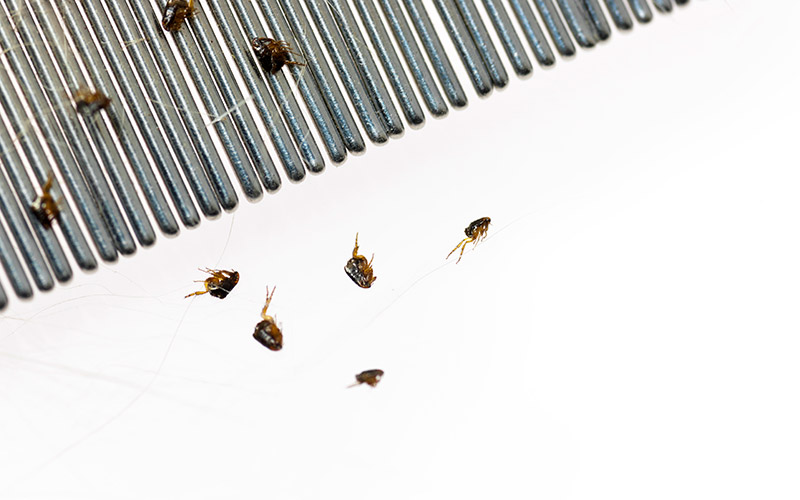
To check for pet fleas, clean pet combs over a white background.
Recognizing Fleas and Flea Problems
If you see household pets scratching vigorously and repeatedly, common cat fleas are probably the reason. Don't let the name fool you — cat fleas afflict dogs, people and other animals along with cats. These tiny, wingless, biting insects measure 1/8 inch or less. That's about the same size as adult deer ticks.
Fleas are visible to the naked eye, but a magnifying glass provides a more in-depth look. Common fleas have thin, semi-translucent, reddish-brown bodies with flattened abdomens designed for moving through thick pet hair. Like other insects, fleas have six legs, including two large, oversized hind legs. Their beak-like mouthparts pierce the skin of their animal host so they can suck on its blood. After a meal, the red blood shows clearly in flea abdomens.
If fleas infest your pets, the humans who live with them are fair game, too. Fleas are known to jump 12 inches or more to reach a warm-blooded host. Human flea bites often occur around ankles and calves. The small, circular, bright red bite sites appear in rows along sock tops or in concentrations. If you hug infested pets, expect bites on your neck, arms and chest as well. Human flea bites itch, but reactions in dogs and cats are generally more severe.1
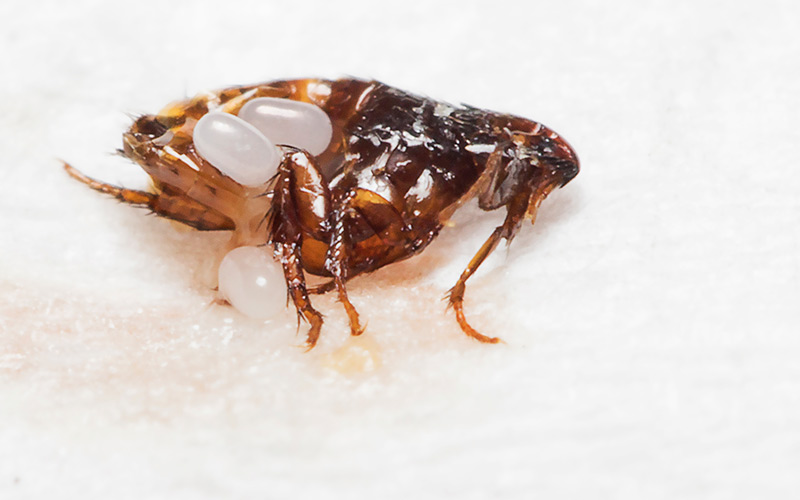
A female flea can lay up to 2,000 eggs over several weeks.
Understanding Flea Life Cycles
Common cat fleas spend almost their entire adult lives living on a host animal. In contrast to internal parasites, these pests live on the outside of their victims. Adult fleas only eat blood.
Cat flea larvae hatch from eggs and go through three legless, worm-like stages. Then they create cocoons and transform into adult fleas. The sticky cocoons attract a camouflage of dust and dirt before adults emerge. Adult fleas immediately seek out warm-blooded hosts and start feeding on blood. Within two hours, adult fleas mate. Within a day, female fleas start laying eggs.
Cat fleas feed up to 15 times a day. Female fleas eat up to 15 times their weight in blood daily. A single adult female flea lays up to 2,000 eggs at a rate of up to 40 eggs per day.1 The pearl-white eggs fall from the host and develop wherever they happen to land. New generations of fleas mature in just three to four weeks. Then those new adults start feeding, mating and laying more eggs. Several generations can occur each year.
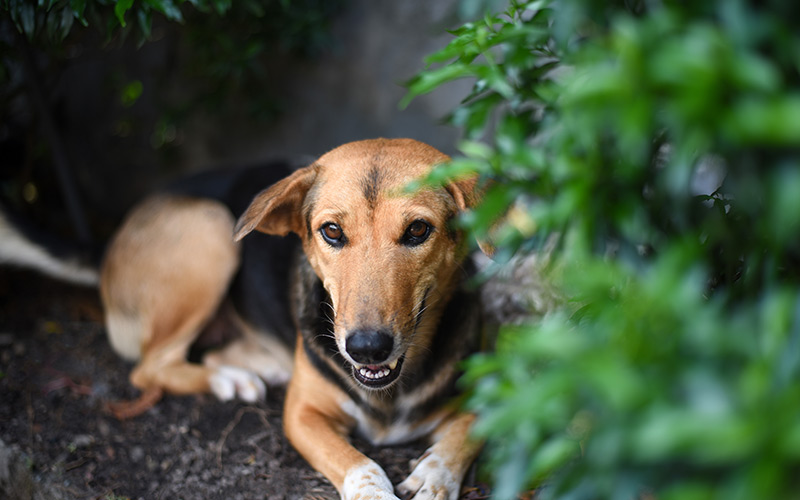
Your pet's favorite shady resting place may harbor fleas and flea larvae.
Protecting Against Fleas and Flea Bites
Effective flea control starts in your yard and kills fleas and flea larvae before they infest pets, come indoors or reproduce. Never apply a lawn and garden flea control product to a pet or person. See your veterinarian or medical doctor for appropriate medicines instead.
The best yard treatment for fleas tackles these pests to kill existing fleas and prevent flea infestations. With Amdro brand pesticides, you can take a multilayered approach to outdoor flea control:
- 1. Treat flea hiding spots in your lawn and landscape, especially those areas under shrubs and trees where pets rest or play. For flea sprays for your yard, turn to Amdro Quick Kill Insect Killer for Lawn & Landscape liquids. These products kill fleas by contact in your lawns, landscape shrubs, flower gardens and foundation plantings. You can even treat your home's foundation up to a height of 3 feet. Use Amdro Quick Kill Insect Killer for Lawn & Landscape Concentrate with a pump-style garden sprayer, or attach Amdro Quick Kill Insect Killer for Lawn & Landscape Ready To Spray to a garden hose. People and pets can reenter treated areas as soon as the spray dries.
- 2. Apply a full flea yard treatment with Amdro Quick Kill Lawn Insect Killer Granules to kill existing fleas by contact. This flea treatment for yards goes on with a standard lawn spreader — and it keeps killing new fleas for up to three months. Pay special attention to areas near plantings and walkways where fleas may wait to jump on passersby. After application, water the treated area lightly to release the formula's active ingredients. Once the watered area dries, it's ready for people and pets again.
- 3. Create a barrier of outdoor protection with Amdro Quick Kill Insect Killer for Home Perimeter granules. This flea killer for yard perimeters kills fleas by contact and provides residual control to prevent new flea infestations for up to three months. These mulch-penetrating granules come in a convenient shaker container that's ideal for use around your home, including around patio areas, foundation plantings and outdoor entertainment areas. Water the treated area after application and let it dry. Then people and pets can enter again.
By taking action with flea-killing yard treatments, you can get rid of outdoor fleas and protect your family and pets from the threat of flea bites and flea-related disease. At Amdro, we're here to help you put an end to fleas, ticks and other pests. Let us help you stop the disruptions so you can start enjoying your yard again.
Always read product labels thoroughly and follow instructions.
Sources:
1. Purdue Medical Entomology, "Fleas," Purdue University.


